
Printing in the Windows Environment
Saving the Number of Printed Sheets
To print multiple pages on the same side of a single sheet ([Combination])
Printing multiple pages on the same side of a single sheet ([Combination])
You can print multiple reduced size pages on the same side of a single sheet to reduce the number of pages to be printed.

In [Combination] in the [Layout] tab, select "N in 1". For example, when you select [9 in 1], every set of nine pages is reduced and printed on the same side of one sheet.
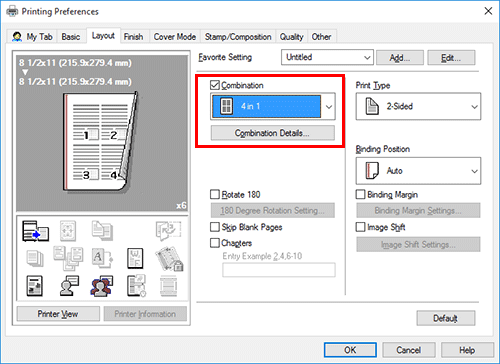
If necessary, click [Combination Details...] to set the page layout order and whether to input border lines between pages.
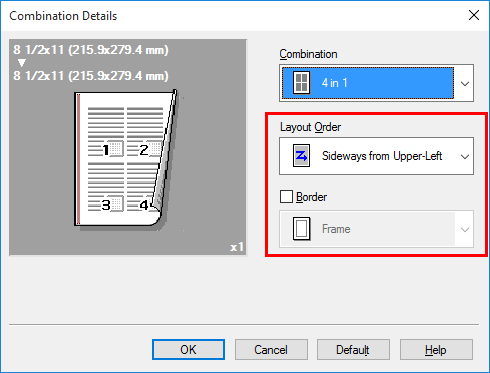
Setting | Description |
|---|---|
[Layout Order] | Select the page layout order. |
[Border] | Select this check box when you want to draw border lines between pages. In addition, select the type of border lines from [Frame] and [Line]. |
By using this function in combination with the 2-Sided Print function ([Print Type]: [2-Sided]), you can save more amount of paper.
To print on both sides of paper ([2-Sided])
Printing on both sides of paper ([2-Sided])
By using both sides of paper for printing, you can reduce paper consumption by half.

In [Print Type] in the [Layout] tab, select [2-Sided]. [2-Sided] is specified by default.
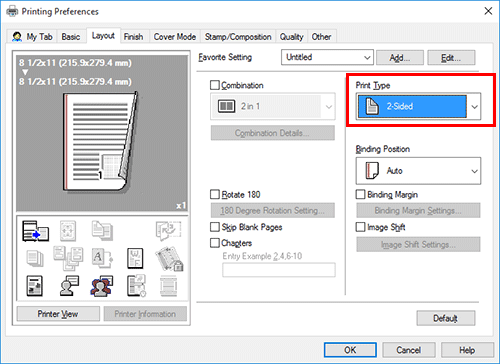
If this function is combined with the Combine function ([Combination]: "N in 1"), you can save more amount of paper.
To skip blank pages for printing ([Skip Blank Pages])
Skipping blank pages ([Skip Blank Pages])
Blank pages contained in the original are skipped when the original is printed. You can reduce the number of printed sheets.
In the [Layout] tab, select the [Skip Blank Pages] check box.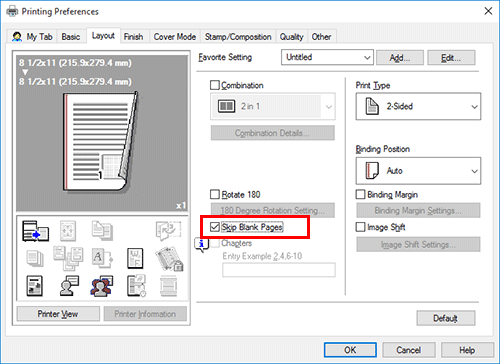
For some originals, blank pages are also printed.
[Skip Blank Pages] is available only when the printer driver for Windows is used.
To save an original in a User Box of this machine ([Save in User Box])
Saving an original in a User Box of this machine ([Save in User Box])
About Save in User Box
The Save in User Box function saves print data in a User Box on this machine. You can also print the data at the same time as it is being saved in the box.
You can use multiple User Boxes for different purposes, for example:
By saving data in a User Box that all users can access (Public Box) or in a User Box that the members of a specific department can access (Group Box), you can distribute the data.
By saving data in the private box (Personal Box), you can assure security because only you can open the box. The data in the box is not deleted by mistake.

Registering a User Box on this machine
Register the boxes for storing print data on this machine.
For information on how to register a User Box, refer to Here.
Registering a User Box (Web Connection) (Here)
Setting Save in User Box on your computer
In [Output Method] in the [Basic] tab, select [Save in User Box].
When you want to print the data at the same time it is saved in the box, select [Save in User Box and Print].
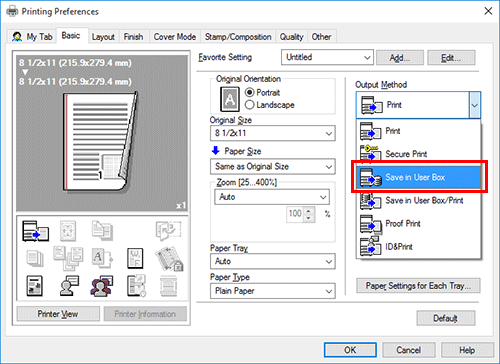
Enter the file name and the box number of the save location, click [OK].
Use a file name that helps you locate the data in the box.
The box number can be checked in the [User Box Information] list. Clicking [Obtain Device Information] obtains the latest information of the box registered in this machine and displays it in the [User Box Information] list.
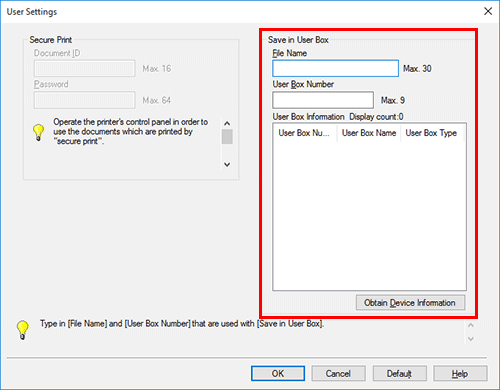
If you always use the same file name and box number, registering them in advance eliminates the need to enter them each time. For details, refer to Here.
Execute printing.
The data is saved in the box on this machine.
[Obtain Device Information] cannot be used when this machine is used via a USB connection.
Enlarging or Reducing an Original Image
To enlarge or reduce the paper size ([Paper Size])
Enlarging or reducing to the paper size ([Paper Size])
The original is printed after it is enlarged or reduced by a ratio that is automatically determined by the original size and paper size.
If you select a paper size larger than the original size, the original is enlarged to the paper size. If you select a paper size smaller than the original size, the original is reduced to the paper size.

In [Paper Size] in the [Basic] tab, select the size of paper for printing. The zoom ratio is automatically determined by the paper sizes selected in [Original Size] and [Paper Size].

This function is enabled when [Zoom] is set to [Auto].
To enlarge or reduce with the desired zoom ratio ([Zoom])
Enlarging or reducing by the desired zoom ratio ([Zoom])
You can print the original image after it has been enlarged or reduced by the desired zoom ratio. The zoom ratio can be specified to be between 25% and 400% (in increments of 1%).

In [Zoom] in the [Basic] tab, specify the zoom ratio. When specifying the common zoom ratio in the vertical and horizontal directions, select [Manual-lock aspect ratio], and specify the zoom ratio. When specifying a different zoom ratio in the vertical and horizontal directions, select [Manual-var. aspect ratio], and specify the zoom ratio.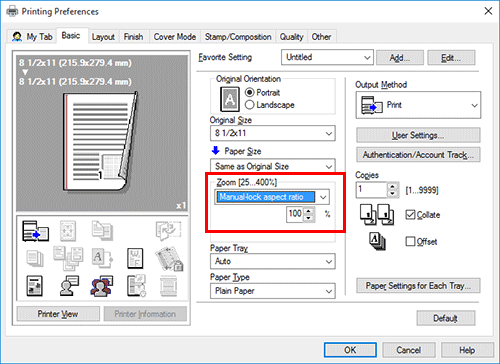
Printing Multiple Sets of Copies
To specify the number of copies ([Copies])
Specifying the number of copies ([Copies])
In [Copies] in the [Basic] tab, specify the number of copies you want to print.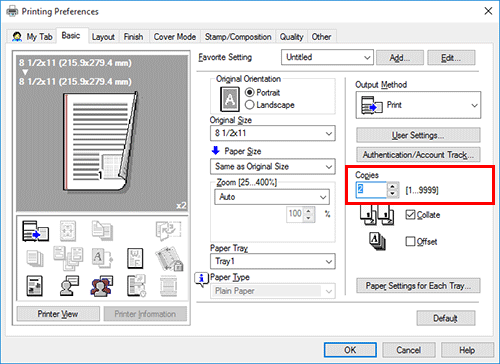
Making a trial printing (Proof Print) (Here)
To print by sets ([Collate]/[Offset])
Printing by sets ([Collate]/[Offset])
Output paper by set when printing multiple sets of copies.
When the [Collate] check box on the [Basic] tab is selected, copies are output separately in a set-by-set manner, for example, "Pages 1, 2, 3, 4, and 5", "Pages 1, 2, 3, 4, and 5", and then "Pages 1, 2, 3, 4, and 5". When the [Offset] check box is selected, the output position is staggered one by one.
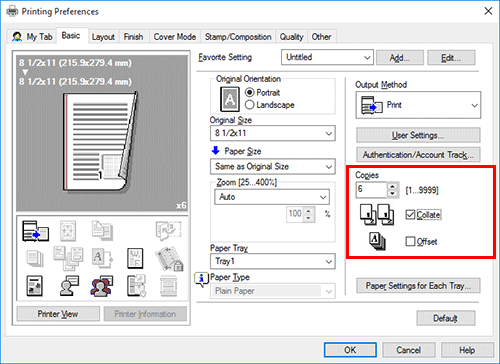
To make a trial printing in order to prevent misprints ([Proof Print])
Making a Trial Printing ([Proof Print])
About Proof Print
The Proof Print function is used when printing multiple copies. It allows the printer to output one copy and pause the printing operation before printing the remaining copies.
Because you can check the print result before starting printing the remaining copies, this function is helpful to prevent a lot of misprints.

Setting Proof Print on your computer
In [Output Method] in the [Basic] tab, select [Proof Print].
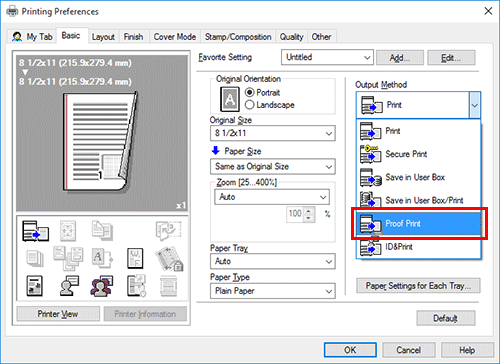
Specify the number of copies, then execute printing.
Only one copy is printed. Then, proceed to "Printing a Proof Print job on this machine".
Printing a Proof Print job on this machine
Tap [Job List] on the home screen.
While [Active] is displayed, tap [Release Held Jobs].

Select the job you want to print.
If necessary, tap [Change Setting] to change the print conditions.
To delete a job, tap [Delete].
Tap [Start].
The remaining copies are printed.
Deleting a Proof Print job
A job, which has been sent to this machine with [Proof Print] enabled, can be deleted remotely using Web Connection via the Web browser of the computer.
Access to Web Connection using the Web browser.
For details on how to access, refer to Here.
Log in to the user mode.
For details on how to login to the user mode, refer to Here.
Click [Job] - [Current Jobs].
Click [Release Held Job].
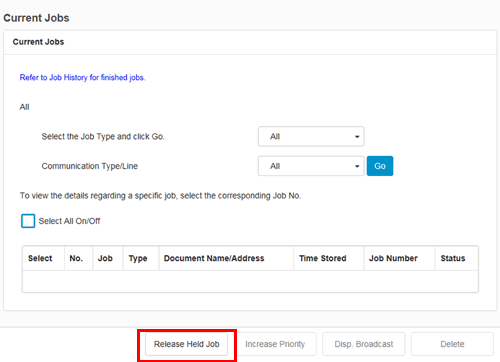
Select the check box of the job to be deleted, and click [Delete].
Click [OK].
The selected job is deleted.
Selecting the Paper Size or Type for Printing
To print on custom-size paper ([Original Size])
Printing on custom-size paper ([Original Size])
For originals with a special size, print them on custom sized paper.
In [Original Size] in the [Basic] tab, select [Custom Size].
In [Paper Size], select [Same as Original Size].
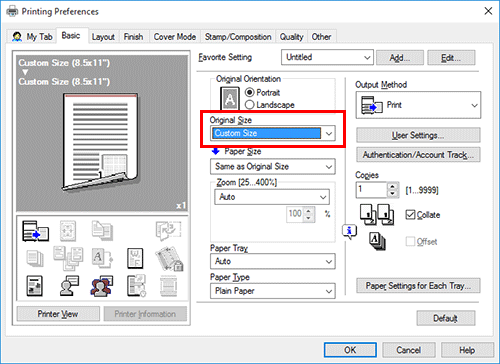
The [Custom Size] setting window appears.
Specify the length and width as desired, and click [OK].
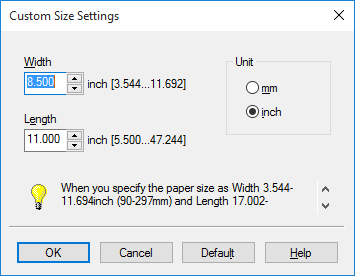
To change the paper type for printing ([Paper Type])
Specifying the paper type for printing ([Paper Type])
In [Paper Type] in the [Basic] tab, select the type of paper for printing.
When [Paper Settings for Each Tray] is enabled in the [Settings] tab of the printer driver, select [Paper Settings for Each Tray...] in the [Basic] tab, and specify the paper type for each tray.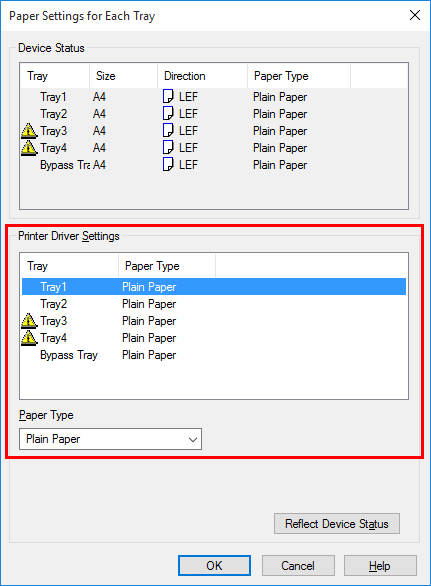
To specify the paper tray for printing ([Paper Tray])
Specifying the paper tray ([Paper Tray])
In [Paper Tray] in the [Basic] tab, select the paper tray for printing.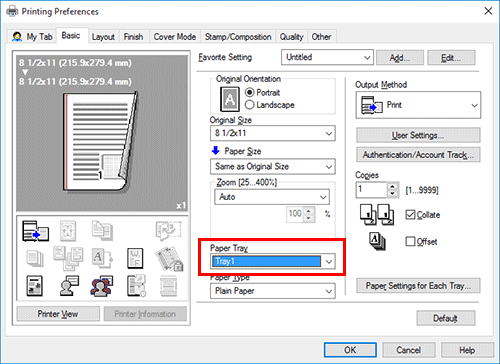
If you select [Auto], the paper tray for the paper you have selected in [Paper Size] is automatically selected.
To collectively print on different colored sheets that have been loaded into multiple trays ([Carbon Copy])
Printing on paper in multiple trays ([Carbon Copy])
You can print the original on different sheets of paper loaded into multiple trays. Because you can obtain printing results that look like carbon-copied slips using the print command once, this function is called Carbon Copy.
For example, by using the print command once, you can print a submission document on high-quality color paper loaded in Tray 1 and print your copy on recycled paper loaded in Tray 2.
This function is useful when you want to create a submission document and its copy at one time.

In [Paper Tray] in the [Basic] tab, select the paper tray for printing the original.
You cannot select [Auto].

In the [Cover Mode] tab, select the [Carbon Copy] check box.
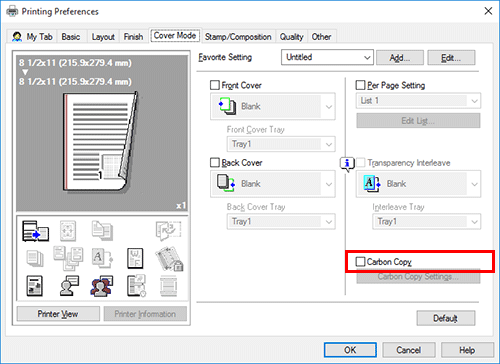
The [Carbon Copy Settings] window appears.
Specify the paper tray for carbon copies and output order, and click [OK].
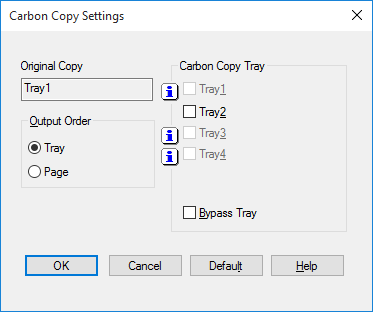
Setting
Description
[Original Copy]
The paper tray for printing the original is displayed.
[Carbon Copy Tray]
Select the paper tray for carbon copies. Select the check boxes for all paper trays to be used.
[Output Order]
Select the order of outputting carbon copies.
[Tray]: Carbon copies are printed in order of selected trays. When an original comprised of multiple pages is printed, all pages are printed on paper from one tray, then the next tray is used.
[Page]: Carbon copies are printed page by page. When an original comprised of multiple pages is printed, each page is printed on paper from all the selected trays.
To print on envelopes or postcards
Printing on Envelopes or Postcards
Execute a print job on your computer then load envelopes or postcards into this machine to execute a print job on it.
The following explains how to print on standard-size envelopes or postcards loaded into the Bypass Tray.
Open the file in the application, and click [File]. Then click [Print] from the menu.
Select this product from [Select Printer] (or [Printer Name]), and click [Preferences] (or [Properties]).
In [Original Size] on the [Basic] tab, select [Envelope] or [Postcard].
Various sizes of envelopes are available. Select the correct paper size for the envelopes you have loaded.
If [Postcard] is selected, [Paper Type] is automatically set to [Thick 3]. If [Envelope] is selected, [Paper Type] is automatically set to [Envelope].
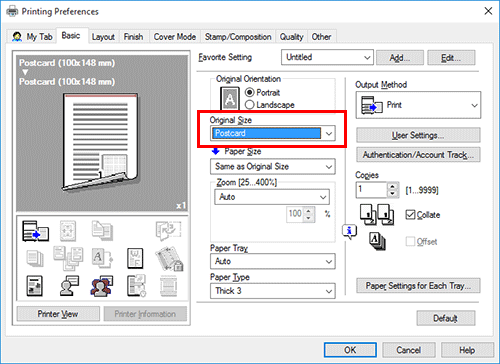
Check that [Paper Size] is set to [Same as Original Size].
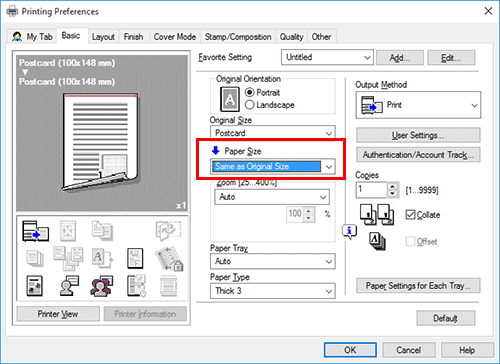
Select [Bypass Tray] from [Paper Tray].
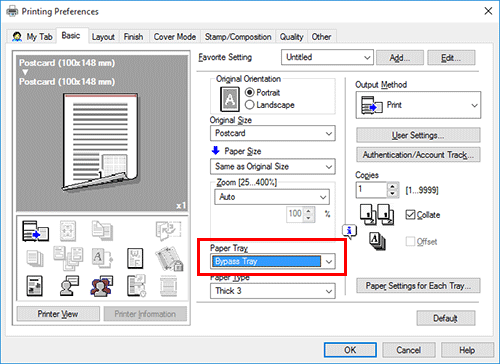
Click [OK].
To load envelopes, open the Right Door, then move the Fusing Adjustment Lever up to the envelope position (top).

Close the Right Door.
Execute printing.
The following screen is displayed.
Load envelopes or postcards into the Bypass Tray with the print side facing down.
Insert envelopes or postcards into the tray until their edges are pressed against the back.
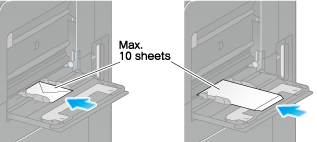


When loading envelopes or postcards into the Bypass Tray, note the following points.
When loading envelopes, remove air from them, and securely press along the flap fold line. Otherwise, it will result in an envelope wrinkle or paper jam.

Do not use envelopes that have glue or release paper on the flap or the part covered by the flap on the body. Otherwise, the machine may be damaged or a failure may occur.
When loading curled postcards, uncurl the postcards as shown in the figure in advance.

Slide the Lateral Guide to fit the size of the loaded paper.


Tapping [Complete] starts printing.
If you cannot tap [Complete], check whether the paper setting of the printer driver matches that of the main unit. In addition, remove envelopes or postcards loaded in the Bypass Tray, then reload them.

When envelope printing has been completed, return the Fusing Adjustment Lever you moved in step 7 to the normal printing position (bottom).
The inside of this product has areas subject to high temperature, which may cause burns. When checking the inside of the unit for malfunctions such as a paper misfeed, do not touch the locations (around the fusing unit, etc.) which are indicated by a "Caution HOT" caution label. A burn could result.
To print on banner paper
Printing on Banner Paper
About printing on banner paper
This machine accommodates paper with a length of up to 47-1/4 inches (1200 mm) in the Bypass Tray.

Printable paper
Paper width | Paper length | Paper weight |
|---|---|---|
8-1/4 to 11-11/16 inches (210 mm to 297 mm) | 17 to 47-1/4 inches (431.9 to 1200.0 mm) | 33-13/16 to 55-7/8 lb (127 g/m2 to 210 g/m2) Using the printer driver, select the paper type appropriate for the weight of the banner paper to be used.
|
How to print on banner paper
Specify the banner paper size.
On the screen of this machine, tap [Utility] - [Banner Printing].
Select [Allow], and tap [OK].
Check that the system is changed to the banner print job wait state.
When you have finished the above settings, start to print from the PC.
In [Original Size] in the [Basic] tab, select [Custom Size].

Specify the length and width of the banner paper, and click [OK].
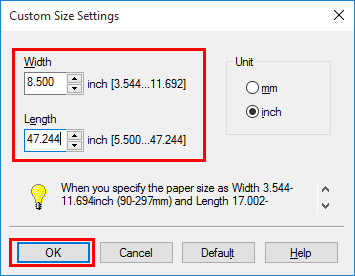
The [Confirm setting changes] dialog box appears.
Click [Yes].
The [Paper Tray], [Paper Type], and [Print Type] settings are switched.
Change the setting of [Paper Type] for Bypass Tray according to the weight of print paper.
Execute printing.
A message that prompts you to load paper is displayed on the screen of this machine.
Load the banner paper into the Bypass Tray.
For information on how to load banner paper into the Bypass Tray, refer to Here.
When you have loaded a banner paper, tap [Complete].
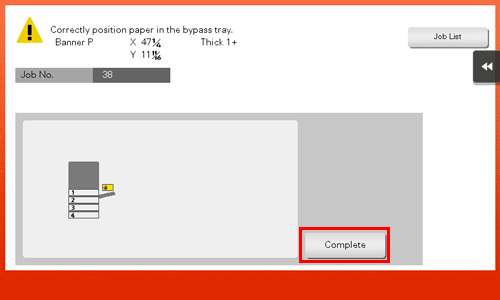
Printing on the banner paper starts. Support the ejected banner paper by hand. To continue printing, execute printing from the computer.
Tap [Exit].
A message confirming the end of banner printing is displayed. To terminate printing, tap [Yes].
If there is a queued job, the job is started.
Adjusting the Color Quality to Obtain a Nice-Looking Print Image
To select colors for printing ([Select Color])
Selecting colors for printing ([Select Color])
Select colors for printing. There are five color modes: [Auto Color] that fits the original color, [Full Color], [Gray Scale], [2 Color (Text Priority)], and [2 Color (Photo Priority)].

In [Select Color] in the [Quality] tab, select a color mode for printing.
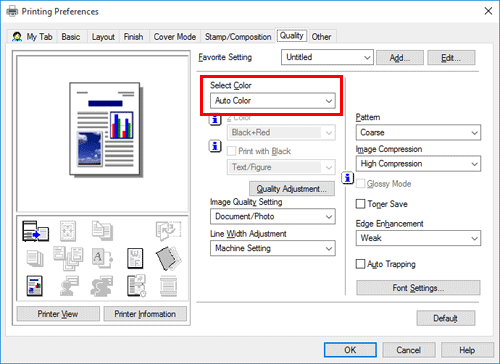
[Full Color] is a function of the PS driver.
[2 Color (Text Priority)] and [2 Color (Photo Priority)] are functions of the PCL driver.
To fine-adjust the image quality according to the original ([Quality Adjustment])
Fine-tuning the image quality according to the original ([Quality Adjustment])
You can fine tune the color image quality according to the original. For example, you can increase the vividness or reduce the color difference.
You can adjust the overall image quality of the original, and you can also adjust in detail the image quality of each element of the original, such as text and photos. When you are using the PCL driver, you can adjust the brightness and contrast.

In the [Quality] tab, click [Quality Adjustment].
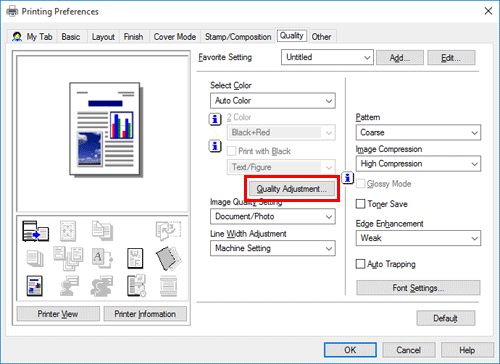
Fine tune the image quality according to the original.
[Simple]: The image quality of the entire original is adjusted. Specify the type of the color profile used for printing.
[Detail]: The image quality of the original is adjusted in detail for each element such as text, photos, figures, tables, and graphs. For each element, specify the type of the color profile used for printing and other profiles to be applied.
Click [OK].
Using ICC Profiles (PS Only) (Here)
To automatically adjust to the available image quality settings for the original ([Image Quality Setting])
Selecting the optimum color representation for the original ([Image Quality Setting])
Select the optimum settings for the original to print it at the optimum image quality level.
Select one of the following processes according to the original to be printed; the process suitable for originals consisting primarily of text, the process suitable for photos, the process suitable for originals created with DTP, or the process suitable for printing CAD data.

In [Image Quality Setting] of the [Quality] tab, select the image setting mode to suit the original.
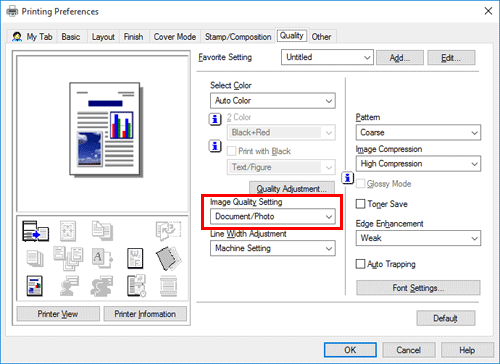
To specify the graphic pattern density ([Pattern]) (PCL only)
Specifying the graphic pattern density ([Pattern]) (PCL only)
In [Pattern] in the [Quality] tab, select the graphic pattern density.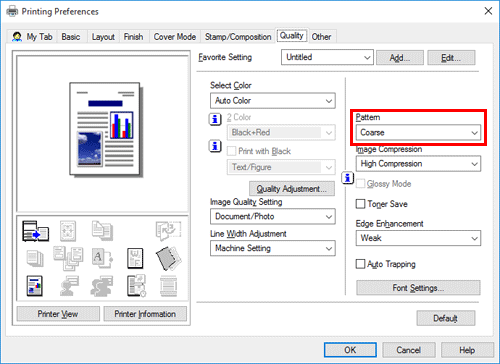
[Pattern] is available only when the printer driver for Windows (PCL) is used.
To specify the compression ratio of graphic images ([Image Compression]) (PCL only)
Specifying the compression ratio of graphic images ([Image Compression]) (PCL only)
In [Image Compression] in the [Quality] tab, select whether the quality or printing speed is preferred when the image data contained in the original is compressed.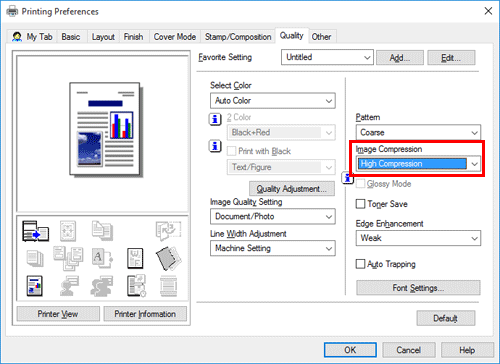
[Image Compression] is available only when the printer driver for Windows (PCL) is used.
To print images with a glossy finish ([Glossy Mode])
Making the image glossy ([Glossy Mode])
Images are printed with a glossy finish.
In the [Quality] tab, select the [Glossy Mode] check box.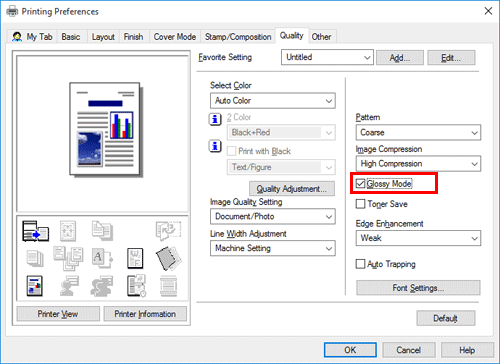
This function is enabled when [Print Type] is set to [1-Sided].
To prevent the generation of white space around images ([Auto Trapping]/[Black Over Print]) (PS only)
Preventing the generation of white space around images ([Auto Trapping]/[Black Over Print] (PS only))
The generation of white space on the boundary between different colors or around characters is prevented.
In the [Quality] tab, select the [Auto Trapping] check box or configure the [Black Over Print] setting.
Select the [Auto Trapping] check box to superimpose neighboring colors to print so as to prevent generation of white space around a picture.
Select the [Black Over Print] check box to superimpose black color on a neighboring color to print so as to prevent generation of white space around black characters or figures. You can select whether to print black only around the characters or around both characters and figures.
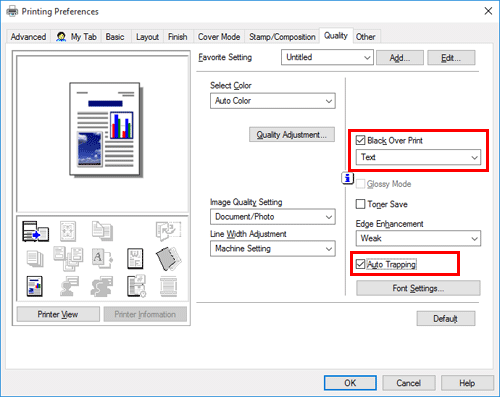
To adjust the printing density in order to reduce toner consumption ([Toner Save])
Saving toner ([Toner Save])
Selecting the [Toner Save] check box in the [Quality] tab adjusts the printing density in order to save the amount of toner consumed.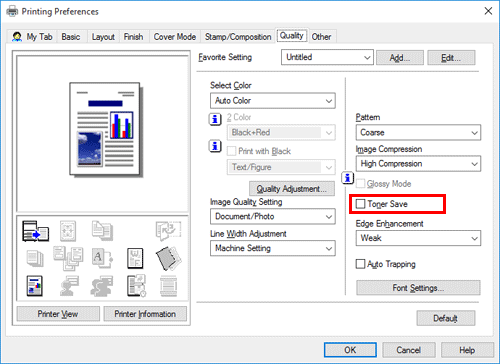
To sharpen the border between text, etc. ([Edge Enhancement])
Sharpening the border between text etc. ([Edge Enhancement])
Sharpen the edges of images such as text in the table and graphics to improve legibility.
In [Edge Enhancement] of the [Quality] tab, select the level to highlight.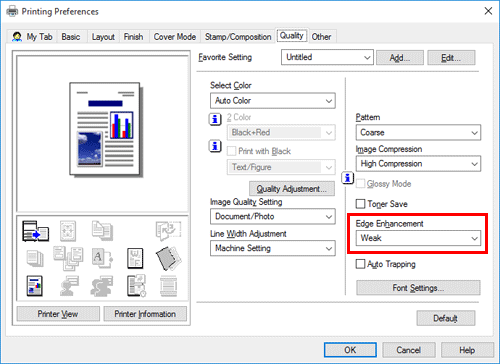
To specify font processing ([Font Settings])
Specifying font processing ([Font Settings])
Specify how the fonts are processed for printing.
In the [Quality] tab, click [Font Settings].
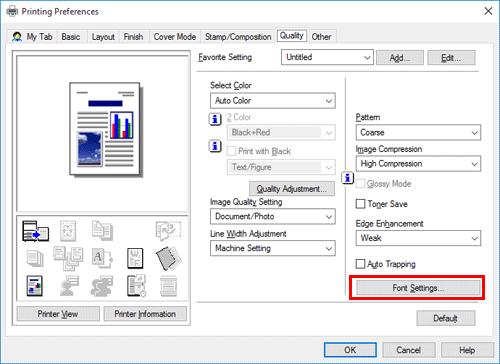
Change how the fonts are processed for printing.
PCL driver
PS driver
Setting
Description
[Download Font Format]
Select a type of fonts to be downloaded from the PC to this machine.
[Use Printer Fonts]
Select this check box to replace TrueType fonts with printer fonts during printing. Use of printer fonts increases the printing speed.
In normal printing operations, we recommend that you select this check box.
[TrueType Font Substitution Table] (PCL only)
Set this table when you want to specify the printer fonts that replace TrueType fonts.
From the list, select the TrueType font, then in [Printer Font to Use], select the printer font with which you want to replace the TrueType font.
Click [OK].
To prevent failure in printing thin lines ([Thin Line Support]) (PCL only)
Preventing failure in printing thin lines ([Thin Line Support]) (PCL only)
Select this option to prevent thin lines from disappearing in reduced-size printing.
In the [Other] tab, select the [Thin Line Support] check box.
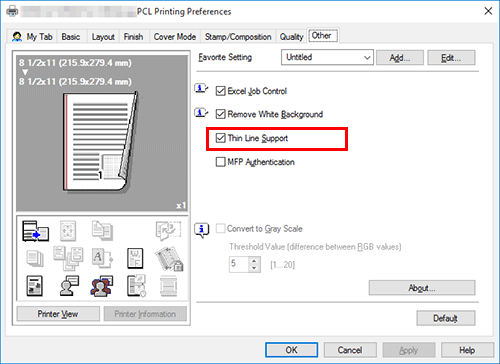
This is effective for thin lines such as table borders created in Excel, but not for thin lines used in illustrations.
[Thin Line Support] is only available only for the Windows printer driver (PCL).
To use the ICC profile (PS Only)
Using ICC Profiles (PS Only)
Specifying the ICC profiles for printing
Specify and print the ICC profiles registered in this machine with the printer driver.
To use the new ICC profiles registered this machine, you need to add the ICC profiles to the printer driver in advance. For details, refer to Here.
In the [Quality] tab, click [Quality Adjustment...].
Click [Detail] and select the element for which the image quality is adjusted.
Click the [ICC Profile] tab.
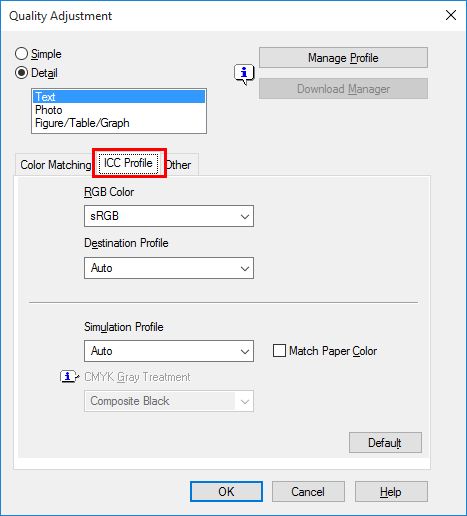
Specify the settings for [RGB Color], [Destination Profile], and [Simulation Profile].
The ICC profiles registered in the printer driver can be selected.
Click [OK].
Color processing is performed according to the selected ICC profiles.
Adding ICC profiles to the printer driver
To use the ICC profiles registered in this machine for printing, you need to add the ICC profiles to the printer driver in advance.
This function is available if the computer can communicate with this machine. The computer communicates with this machine and loads ICC profiles that the machine can use.
This function cannot be used when this machine is used via a USB connection.
To register ICC profiles in this machine, use Download Manager. For details on how to register ICC profiles in this machine, refer to the Help for Download Manager.
In the [Quality] tab, click [Quality Adjustment...].
Click [Manage Profile].
When the Download Manager has been installed, if you click [Download Manager], Download Manager starts.
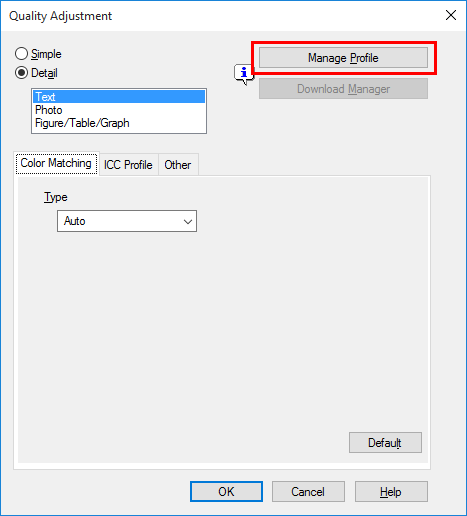
Click the tab and select a color profile type.
From the [Available Profile] list, select the profile you want to add to the printer driver, then click [Add Sel].
To register the current driver settings as the profile, click [New], then enter the [File Name] and [Profile Name].
To edit the profile name, click [Edit].
Click [OK].
The profile is added to [Driver Profile List].
Finishing in Handouts or Booklet Format
To staple paper ([Staple])
Stapling paper ([Staple])
Each set of sheets can be stapled (at a corner or at two positions) and output automatically. This function is useful for preparing a project proposal or other booklet materials.
In the [Finish] tab, select the [Staple] check box. In addition, specify the number and positions of staples.
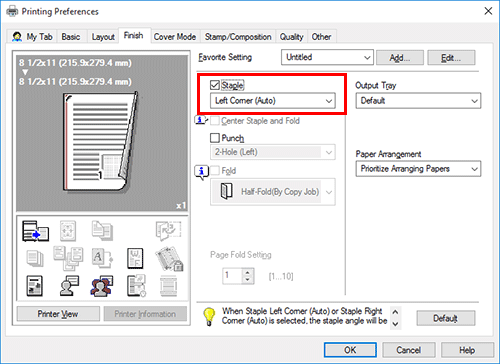
To use this function, an option is required. For details on the required option, refer to Here.
In [Binding Position] in the [Layout] tab, specify the staple position.
To add a margin on pages ([Binding Margin])
Adding a margin on pages ([Binding Margin])
A margin for binding is added on pages.
In the [Layout] tab, select the [Binding Margin] check box.
In [Binding Position] in the [Layout] tab, specify the margin position.
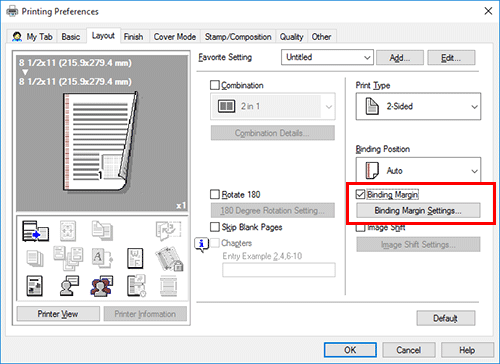
Click [Binding Margin Settings...].
Adjust the size of margin and click [OK].
Setting
Description
[Shift Mode]
Select how the images are shifted for creating the margin.
[Front Side]/[Back Side]
Specify the size of the margin on the front side.
When you print on both sides, specify the size of the margin on the back side. When the [Same value for front and back sides] check box is selected, a margin of the same size is created on both front and back sides.
To punch the printed sheets ([Punch])
Punching the printed sheets ([Punch])
Printed sheets are punched for filing before they are output. This function is useful when you want to bind printed materials in files.
In the [Finish] tab, select the [Punch] check box. In addition, specify the number and positions of punch holes.
To use this function, an option is required. For details on the required option, refer to Here.
In [Binding Position] in the [Layout] tab, specify the punch position.
The number of punched holes varies depending on the area you are in.
To fold paper ([Fold])
Folding paper ([Fold])
The printed sheets are creased before they are output.
Half-Fold

Tri-Fold

In the [Finish] tab, select the [Fold] check box, and select the folding mode.
When you want to fold page by page, specify the number of pages to be folded at one time in [Page Fold Setting].
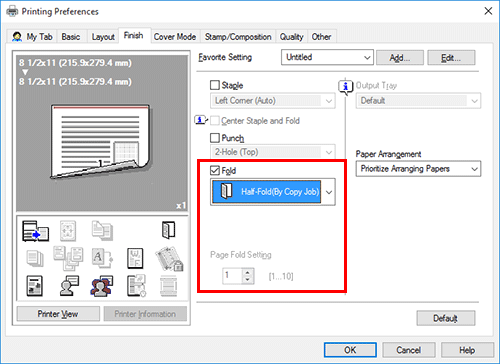
To use this function, an option is required. For details on the required option, refer to Here.
This function cannot be used on originals that contain more pages than the number of pages that can be folded by this machine.
To print in booklet format ([Booklet])
Printing in a booklet format ([Booklet])
The pages in the original data are arranged and spread out in booklet format and printed on both sides of sheets. When the printed sheets are stacked and folded in two, the pages are arranged in the correct order.
In [Print Type] in the [Layout] tab, select [Booklet].

When paper is folded as a booklet, the finishing size is half that of the paper size you selected in [Paper Size].
By selecting [Fold] or [Center Staple and Fold] in the [Finish] tab in combination with this function, you can create booklet-form documents by folding the printed sheets in the center or by binding them using two staples in the center.
By selecting [Chapters] in the [Layout] tab in combination with this function, you can place the specified page on the front side.
To bind in the center of the paper ([Center Staple and Fold])
Binding in the center of the paper ([Center Staple and Fold])
The printed sheets are bound in the center and folded before they are output.

In the [Finish] tab, select the [Center Staple and Fold] check box.
As the sheets are bound in the center, use the combined document data or set the [Print Type] to [Booklet] on the [Layout] tab.
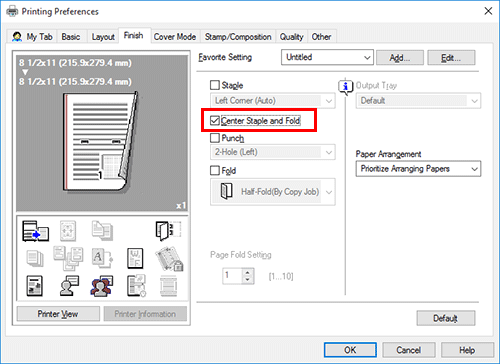
To use this function, an option is required. For details on the required option, refer to Here.
To specify the output tray ([Output Tray])
Specifying the output tray ([Output Tray])
In [Output Tray] in the [Finish] tab, select the tray to which printed sheets are output.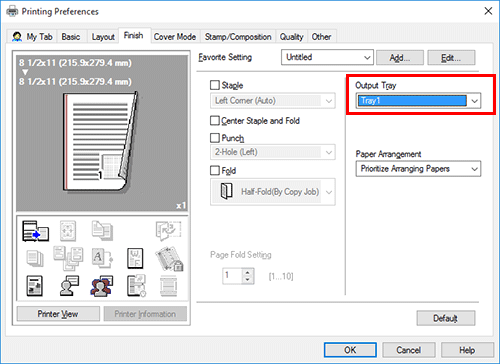
Adding the Date/Time, Page Number, or Stamp to Printouts
To add a watermark ([Watermark])
Adding a watermark ([Watermark])
Text such as "NO REPRODUCTION" and "INTERNAL USE" are printed on the center of all pages in a tint color.
By printing a watermark, you can specify the handling policy of copied documents.

In the [Stamp/Composition] tab, select the [Watermark] check box. In addition, select the watermark you want to print.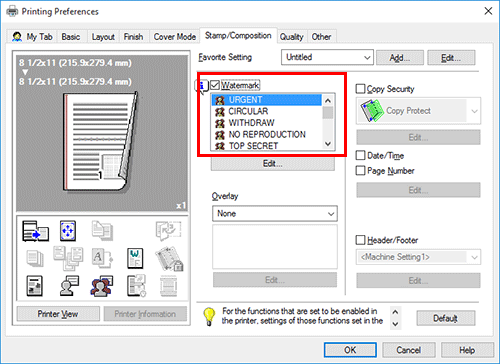
[Watermark] is available only when the printer driver for Windows is used.
To compose an overlay image ([Overlay])
Composing an overlay image ([Overlay])
An overlay image registered in the computer or this machine is recalled and printed on the original as a composite image.

In [Overlay] in the [Stamp/Composition] tab, select [Print Host Image] or [Print Device Image] (PCL only), and then from the list, select the overlay image to be printed on the original as a composite image.
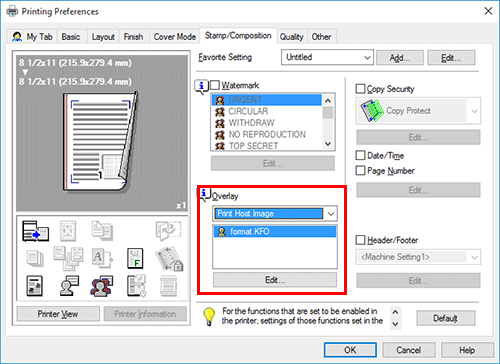
As necessary, click [Edit...] to add or delete overlay images. Alternatively, change the method of composing an overlay image.
When you have selected [Print Host Image]:
Setting | Description | |
|---|---|---|
[Select Overlay File] | Add or delete overlay images. | |
[Browse Files...] | Add an overlay image to the list. | |
[Delete] | The selected overlay images are deleted from the list. | |
[Change 2nd Page and Later] | Select this check box to change the overlay image to be printed on the second and subsequent pages of the original. In addition, from the list, select the overlay image you want to use. | |
[File Information] | Information on the selected overlay image is displayed. | |
[Overlay Print Setting] | If necessary, change the method of composing an overlay image. | |
[Pages] | Select the range of pages on which an overlay image is composed. | |
[Overwrite] | Select whether to compose the overlay image by overwriting the image on the front side of the original, or to composite it on the back side of the original. | |
When you have selected [Print Device Image]:
Setting | Description | |
|---|---|---|
[Obtain Device Information] | If your computer can communicate with this machine, your computer obtains and displays the latest information on the overlay images registered in this machine. | |
[Overlay Info] | Information on the overlay image selected from the list is displayed. | |
[Print on Front Side]/[Print on Back Side] | Select this check box to compose an overlay image on the front and back sides. In addition, specify how to compose an overlay image. | |
[Overlay Name] | Select the overlay image to be composed. Click [Browse...] to confirm the detailed overlay information. | |
[Select Color] | Select the color of the overlay image to be composed. | |
[Density] | Specify the density of the overlay image to be composed. | |
[Overwrite] | Select whether to compose the overlay image by overwriting the image on the front side of the original, or to compose it on the back side of the original by watermarking the image. | |
[Same as Front Side] | Select this check box to apply the settings for the front side to the back side. | |
[Pages] | Select the range of pages on which an overlay image is composed. | |
[Overlay] is only available when the printer driver for Windows is used.
To add the print date/time or page number ([Date/Time]/[Page Number])
Adding the print date/time or page number ([Date/Time]/[Page Number])
You can add the print date/time or page number to your printouts. If necessary, you can select the print position and format of the text.
Date/Time

Page Number

In the [Stamp/Composition] tab, select the [Date/Time] or [Page Number] check box.
As necessary, click [Edit...] to change the print position and format of the text.
Setting | Description | |
|---|---|---|
[Date/Time] | Change the print position or format of the date/time. | |
[Format] | As necessary, click [Edit...] to specify the date/time format or whether to print the time. | |
[Pages] | Specify the range of pages on which the date/time is printed. | |
[Text Color] | Select the print color for the date/time. | |
[Print Position] | Specify the print position for the date/time. | |
[Page Number] | Change the print position of page numbers and the page from which the page number printing starts. | |
[Starting Page] | Specify the page from which the page number printing starts. | |
[Starting Page Number] | Specify the page number to be printed on the page specified in [Starting Page]. | |
[Cover Mode] | Select this check box to print page numbers on the front and back covers when they are inserted. In addition, select the format. | |
[Text Color] | Select the print color for the page numbers. | |
[Print Position] | Specify the print position for the page numbers. | |
To add information to the header/footer ([Header/Footer])
Adding information to the header/footer ([Header/Footer])
You can add and print the date and time and arbitrary text in the top or bottom margin (header/footer) of the original. You must register the information to be added for the header and footer in advance on this machine. For details on the registration procedure, refer to Here.

In the [Stamp/Composition] tab, select the [Header/Footer] check box. In addition, select the information you want to add to the header/footer.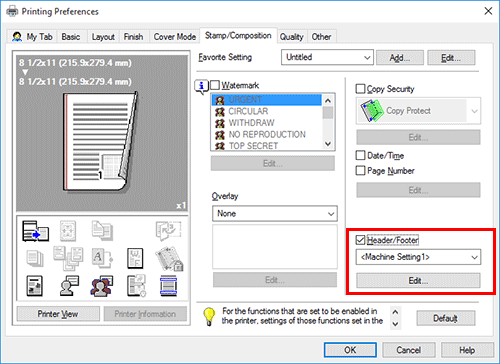
As necessary, click [Edit...] to change the range of pages on which the header/footer is printed and other settings.
Setting | Description |
|---|---|
[Recall Header/Footer] | Select the header/footer to be recalled. If your computer can communicate with this machine, clicking [Obtain Device Information] obtains and displays the latest header/footer information registered in this machine. |
[Distribution Control Number] | Select whether to print copy numbers when printing multiple sets of copies.
As necessary, click [Edit...] to specify the copy number format and the page from which the copy number printing starts. |
[Pages] | Select the range of pages on which the text is printed in the header/footer. |
[Text Color] | Select the color of the text to be added to the header/footer. |
Inserting a Front Cover or Different Original Page into the Original
To insert front and back covers ([Front Cover]/[Back Cover])
Inserting front and back covers ([Front Cover]/[Back Cover])
You can insert a cover sheet before the first page or after the last page of the text.
The front and rear cover sheets can be a paper different from body pages (in paper color and thickness). You can print them at a time.

In [Paper Tray] in the [Basic] tab, select the paper tray for printing the body pages.
You cannot select [Auto].

In the [Cover Mode] tab, select the [Front Cover] or [Back Cover] check box.
If necessary, you can select whether to print the original on the inserted sheets or to leave them blank. When the inserted sheets are printed, the first page of the original is printed on the front cover and the last page of the original is printed on the back cover.
In [Front Cover Tray] or [Back Cover Tray], select the paper tray for the paper to be used as the front cover or the back cover.
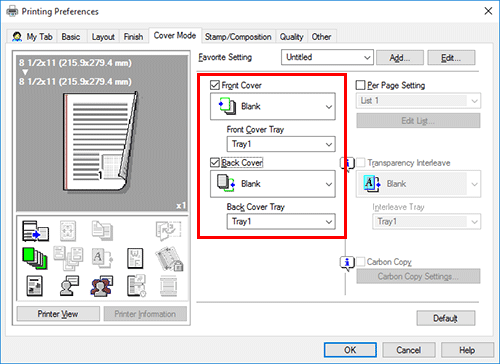
To print by inserting paper between transparencies ([Transparency Interleave])
Inserting paper between transparencies ([Transparency Interleave])
When printing on multiple transparencies, you can insert the specified paper between the transparencies. These sheets of paper prevent the transparencies from sticking together due to heat generated during printing or static electricity.

In [Paper Type] in the [Basic] tab, select [Transparency].
If you select [Transparency], the [Print Type] is set to [1-Sided], and the [Select Color] is set to [Gray Scale].
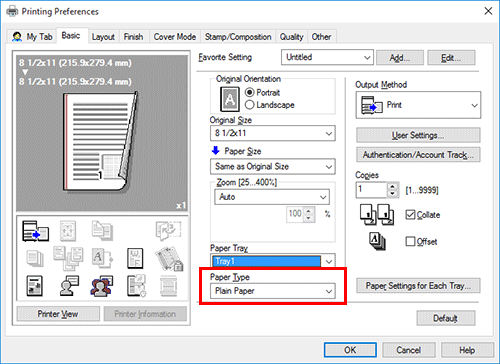
In the [Cover Mode] tab, select the [Transparency Interleave] check box.
In [Interleave Tray], select the paper tray for the paper to be inserted between transparencies.
Transparency interleaves are inserted as blank sheets.
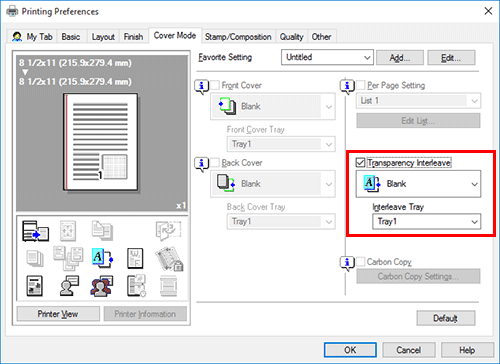
To insert paper into the specified pages ([Per Page Setting])
Inserting paper into the specified pages ([Per Page Setting])
Paper different from other pages is inserted into the specified pages.
You can insert a color paper and a thick paper. You can also select whether to print the original on the inserted paper.

Create in advance a list that specifies the paper and print settings for each page. When printing on inserted paper, select the list you want to apply to printing.
In the [Cover Mode] tab, select the [Per Page Setting] check box, then click [Edit List...].
When you have already prepared a list, select the list you want to apply to printing.
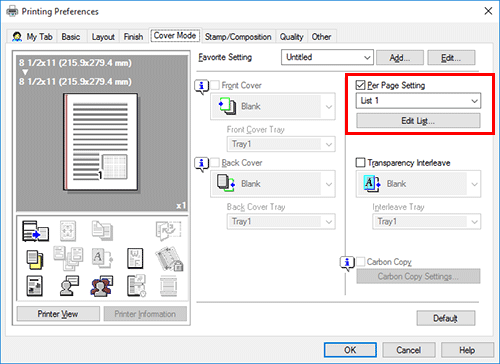
Create a list by specifying the paper and print settings for each page.
Setting
Description
[Settings List]
The settings for each page are displayed in a list.
[List Name]
Select the list to be created.
[Edit List Name]
If necessary, change the list name.
[Up]/[Down]
These buttons move the order of settings in the list. They do not change the settings.
[Add]
This button adds the setting to the list.
[Delete]
This button deletes the setting selected in the list.
[Add/Edit]
You can add settings to the [Settings List] or edit settings.
[Page Number]
Enter the page numbers you want to add.
To specify multiple page numbers, separate each number with a comma (for example, "2,4,6") or connect the numbers using a hyphen (for example, "6-10").
[Change Settings]
Change the setting for the item selected in the [Add/Edit] list.
[Print Type]: Select the print type applied when printing the specified pages.
[Paper Tray]: Select the paper tray for printing the specified pages.
[Staple]: Select the staple position applied when the specified pages are stapled.
Click [OK].
Adjusting the Layout for Printing
To print a poster-sized image ([Combination]) (PCL only)
Printing a poster-sized image ([Combination]) (PCL only)
The original image is enlarged, divided, and printed on multiple sheets. When you join the printed sheets together, a large poster is created.
In [Combination] in the [Layout] tab, select "N N". For example, when you select [2 2], one page of the original image is enlarged, divided, and printed on four sheets.
As necessary, click [Combination Details...] to select whether to create overlap margins.
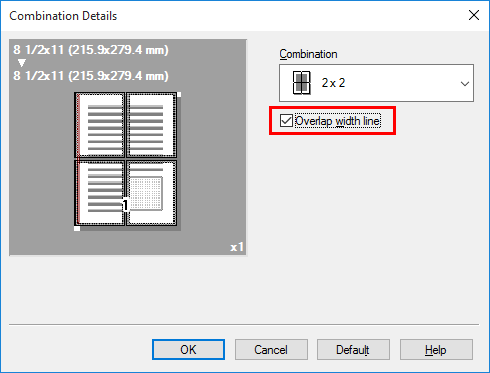
To rotate the image 180 degrees ([Rotate 180])
Rotating the image 180 degrees ([Rotate 180])
The image is printed upside down. Use this function when printing on envelopes whose loading direction cannot be changed.
In the [Layout] tab, select the [Rotate 180] check box.
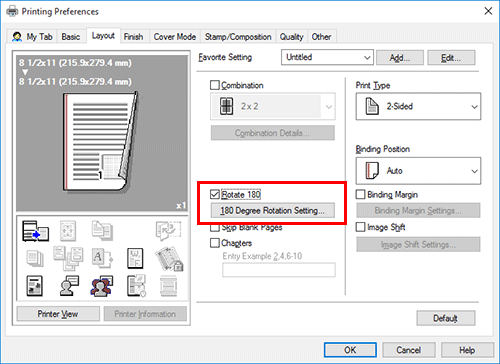
Click [180 Degree Rotation Setting...].
Specify the original to rotate at 180 degrees, then click [OK].
To fine-adjust the printing position ([Image Shift])
Fine-tuning the print position ([Image Shift])
You can fine tune the image position by shifting it in a horizontal or vertical direction according to the paper size. When an image is printed on the back side, you can also fine tune its position.
Use this function when you want to make a fine adjustment, such as changing the print position a little or printing images in different positions between the front and back sides.

In the [Layout] tab, select the [Image Shift] check box.

Click [Image Shift Settings...].
Adjust the upward/downward and rightward/leftward shift distances, and click [OK].
When printing images on both sides, selecting the [Same value for Front and Back sides] check box applies the same settings to both sides.
Restricting a Handout Copy or Printing a Highly Confidential Document
To print a concealed security watermark that appears when copied ([Copy Protect])
Printing a concealed security watermark ([Copy Protect])
Text such as "Copy" and "Private" are printed in the background pattern as concealed text. This function is called the Copy Protect function.
When a copy-protected document is copied, the concealed security watermark appears on the entire page, thereby indicating that it is an unauthorized copy.

In the [Stamp/Composition] tab, select the [Copy Security] check box, and then select [Copy Protect].
As necessary, click [Edit...] to specify the text to be printed and the format of the text. For details, refer to Here.
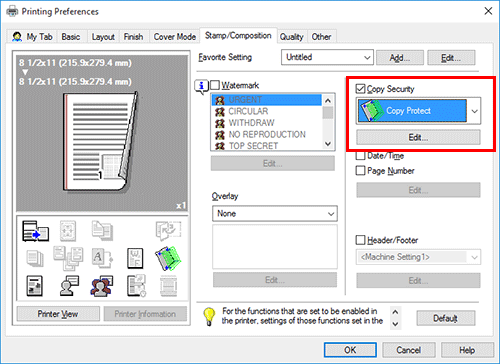
To print stamps such as "Copy" and "Private" on the entire page ([Stamp Repeat])
Printing a stamp on the entire page ([Stamp Repeat])
Print a stamp such as "Copy" or "Private" on the entire page.
By printing text such as "Copy" or "Private" as a visible stamp, you can deter unauthorized copying.

In the [Stamp/Composition] tab, select the [Copy Security] check box, and then select [Stamp Repeat].
As necessary, click [Edit...] to specify the text to be printed and the format of the text. For details, refer to Here.
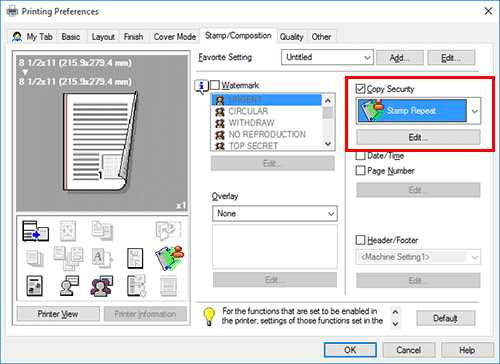
To print a highly confidential document ([Secure Print])
Printing Highly Confidential Documents ([Secure Print])
About Secure Print
Secure Print is a function that assigns document ID and password to print data and saves the data to the Secure Print User Box of this machine. This function does not print data immediately, thereby preventing printed materials from being missing or left.
You need to enter the document ID and password on the screen of this machine to print the data saved in a User Box. Therefore, this function is particularly suitable for safely printing highly confidential documents.

Enabling simple printing for secure print document (for the administrator)
If simple printing for secure print document is enabled, the computer login name is used as the document ID for Secure Print, so you can skip the entry of the document ID.
Also, if the computer login name is used as the document ID for Secure Print, it prevents the document ID from being duplicated with that of another user, which simplifies document management on this machine.
When making prints on the machine, the user can display a list of document IDs on the screen of this machine and easily specify the target document ID.
To enable simple printing of secure documents, configure the following settings.
Enable simple printing of secure documents on this machine (default: [Do Not Release Secure Print]). For details on the setting procedure, refer to Here.
In [Device Option] of the [Configure] tab on the printer drive, set [Security Document Setting] to [Release Secure Print] (default: [Do Not Release Secure Print]). For details on [Device Option], refer to Here.
When simple printing is disabled, the document ID can be specified using up to 16 characters. If simple printing is enabled, the document ID can be extended to up to 64 characters.
If simple printing is changed from Enable to Disable while the document ID is specified using 17 or more characters, it will cause document operations to fail.
Setting Secure Print on your computer
A single job enables you to print out a document of up to 2999 pages in length.
In [Output Method] in the [Basic] tab, select [Secure Print].

Enter the document ID and password, then click [OK].
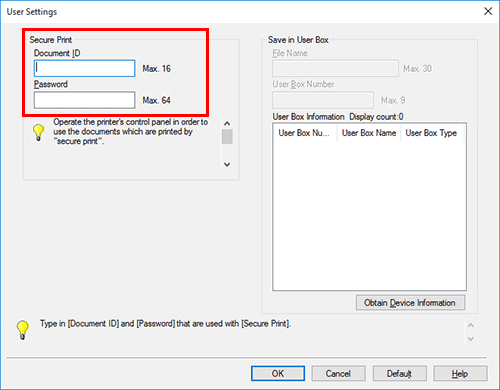
If you always use the same document ID and password, registering them in advance eliminates the need to enter them each time. For details, refer to Here.
Execute printing.
The data is saved in the Secure Print User Box. Then, proceed to "Printing a Secure Print job on this machine".
You can issue a print instruction from the screen of this machine before print data scanning on this machine is completed. However, printing is executed after print data scanning on this machine has been completed.
Printing a Secure Print job on this machine
Data printed using the Secure Print function is saved in the Secure Print User Box. To print the saved data, you need to enter the document ID and password specified in the printer driver.
For details on the printing procedure, refer to Here.
Printing in the Environment with User Authentication Installed
To add authentication information for printing
Attaching Authentication Information
About printing with authentication enabled
When printing a document in an environment where user authentication or account track is employed, you need to send the authentication information (user name and password) to this machine to execute printing. This requirement limits the users who can use this machine, preventing unauthorized use by a third party.
When this machine receives a print job from a user who is not allowed to print or a print job without authentication information, this machine automatically discards the job.

A print job without authentication information refers to a print job that is directly sent to this machine from an enterprise system such as ERP (Enterprise Resource Planning) or a print job that is sent without correctly configuring the User Authentication/Account Track setting using the printer driver.
By default, the printing of a job without authentication information is prohibited. To permit printing, the appropriate setting is required in [Print without Authentication] (Here). If printing is permitted, the unregistered user or account can execute printing even despite the intention of the administrator. If there is any problem on security or management, you should not change the initial settings.
Enabling user authentication or account track on the printer driver
In the [Configure] tab of the printer driver, check that the User Authentication/Account Track setting is correctly configured.
Display the [Properties] window of the printer driver.
For information on how to display the [Properties] window, refer to Here.
In [Device Option] in the [Configure] tab, check that the User Authentication/Account Track setting is correctly configured for your operating environment.
If it is not configured correctly, select [User Authentication] or [Account Track] from the list, then change the relevant setting in [Setting].

Click [OK].
Setting authentication information on your computer
In the [Basic] tab, click [Authentication/Account Track...].
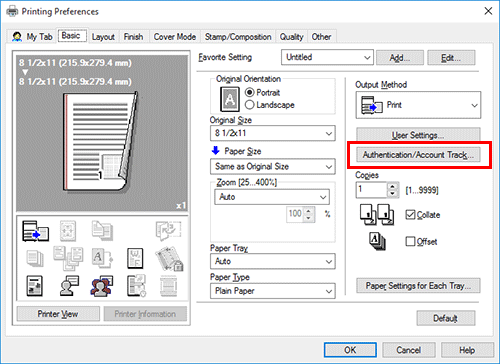
When user authentication is enabled, select [Recipient User], then enter the user name and password.
When this machine is accessible to public users (unregistered users), selecting [Public User] enables you to execute printing without entering the user name and password.
When an external authentication server is used, click [Server Setting...] and select the authentication server.
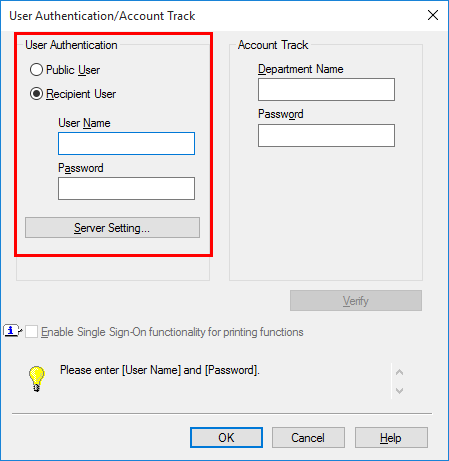
The login name in the PC is displayed in the [User Name] field.
If you always use the same user name and password, registering them in advance eliminates the need to enter them each time. For details, refer to Here.
If account track is enabled, enter the account name and password.
If you always use the same account name and password, registering them in advance eliminates the need to enter them each time. For details, refer to Here.
Click [OK].
If your computer can communicate with this machine, clicking [Verify] executes authentication based on the authentication information that has been input. You can check the authentication information for errors before starting printing.
To perform MFP authentication when external server authentication is used together, select the [MFP Authentication] check box in the [Other] tab.
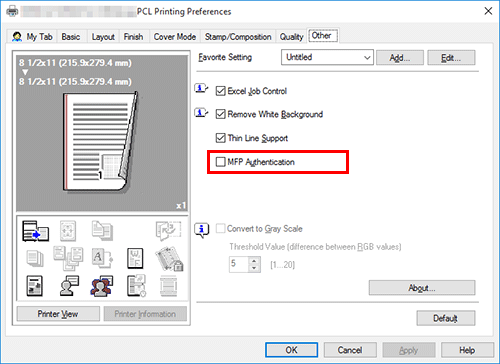
Execute printing.
Printing starts successfully when the authentication information is judged to be correct.
To print a highly confidential document ([ID & Print])
Printing Simultaneously with Authentication on this Machine ([ID&Print])
About ID & Print
ID & Print is a function that saves print data to the ID & Print User Box of this machine when user authentication is installed. This function does not print data immediately, thereby preventing printed materials from being missing or left.
You need to perform user authentication on this machine to print the data saved in the User Box. Therefore, this function is suitable for safely printing highly confidential documents. When authentication succeeds, the print data of the login user is automatically printed. This enhances security as well as ensures smooth operation.

Setting ID & Print on your computer
A single job enables you to print out a document of up to 2999 pages in length.
In the [Basic] tab, click [Authentication/Account Track...].

Enter the authentication information, and click [OK].
The login name in the PC is displayed in the [User Name] field.
For details, refer to Here.

In [Output Method], select [ID&Print].
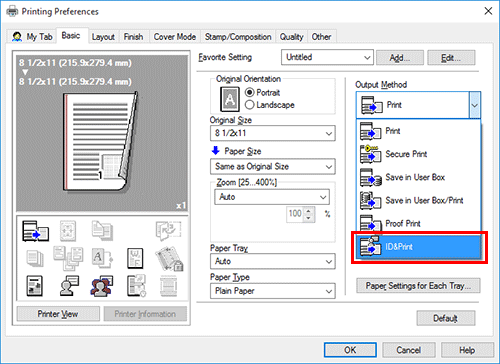
Execute printing.
The data is saved in the ID & Print User Box. Then, proceed to "Printing an ID & Print job on this machine".
You can issue a print instruction from the screen of this machine before print data scanning on this machine is completed. However, printing is executed after print data scanning on this machine has been completed.
Printing an ID & Print job on this machine (when printing all jobs)
Enter the user name and password.
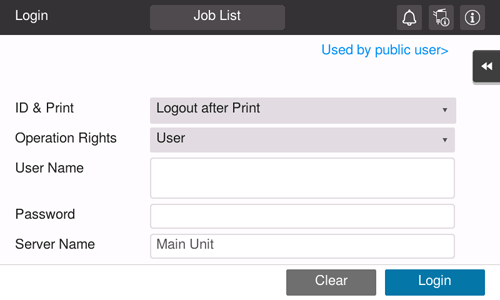
Check that [Logout after Print] is selected in [ID & Print], and tap [Login].
Selecting [Logout after Print] automatically logs out after data printing.
Selecting [Login without Print] logs out without printing data. You can open ID & Print User Box in User Box mode, and print only the specific data in the User Box. For details, refer to Here.
Selecting [Login after Print] logs in after data printing. [Login after Print] is displayed when [Change to Basic Screen after ID & Print] (Here) is set to [ON].
When you are successfully authenticated, all data items saved in the ID & Print User Box are printed.
Printing an ID & Print job on this machine (when printing a specific job)
This section describes how to select and print a file from the ID & Print User Box.
Enter the user name and password.

In [ID & Print], select [Login without Print].
Tap [Login].
Tap [ID & Print] on the home screen.
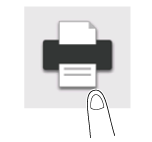
Tap the file to be printed.
Tapping the setting icon in the upper-right side allows you to change any print setting.
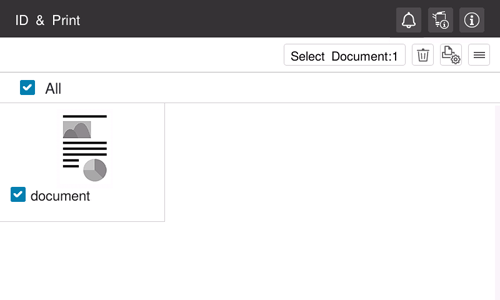
Use the Start key to start printing.
Printing an ID & Print job on this machine (with Authentication Unit used)
You can make prints easily by performing authentication using the Authentication Unit.
Check that [Authentication Device] is selected in [Authentication Method].
Check that [Logout after Print] is selected in [ID & Print], and select Authentication Unit.
Selecting [Logout after Print] automatically logs out after data printing.
Selecting [Login without Print] logs out without printing data. You can open ID & Print User Box in User Box mode, and print only the specific data in the User Box. For details, refer to Here.
Selecting [Login after Print] logs in after data printing. [Login after Print] is displayed when [Change to Basic Screen after ID & Print] (Here) is set to [ON].
When you are successfully authenticated, all data items saved in the ID & Print User Box are printed.
To print in the single sign-on environment of Active Directory
Printing in the Single Sign-on Environment of Active Directory
About single sign-on
When the print service of this machine joins a domain of Active Directory, users can execute printing from computers in the same domain without entering the authentication information (user name and password). The authentication information entered in the login page on the computer is used for this authentication.

Enabling single sign-on in the printer driver
In the [Configure] tab of the printer driver, check that the User Authentication and Single sign-on settings are correctly configured.
Before using this function, configure a setting to join this machine in the Active Directory domain. For details, refer to Here.
Display the [Properties] window of the printer driver.
For information on how to display the [Properties] window, refer to Here.
In [Device Option] in the [Configure] tab, check that the [User Authentication] and [Single Sign-On] settings are correctly configured for your operating environment.
If they are not configured correctly, select [User Authentication] and [Single Sign-On] from the list, and then change the relevant settings in [Setting].
You can set the [Single Sign-On] option to [Enable] if you have set the [User Authentication] to [ON (External Server)] or [ON (MFP) + ON (External Server)].
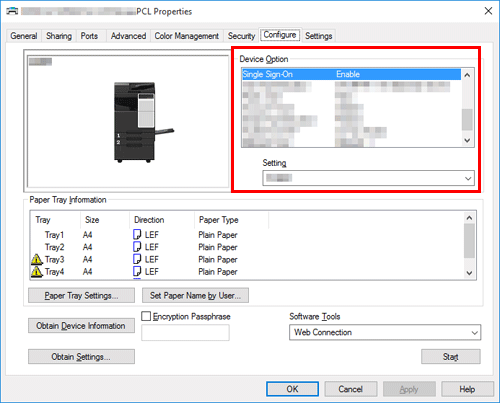
Setting single sign-on on your computer
In the [Basic] tab, click [Authentication/Account Track...].

Check [Enable Single Sign-On functionality for printing functions] box, and click [OK].
The login name in the PC is displayed in the [User Name] field.

Click [OK].
Execute printing.
Printing starts.



